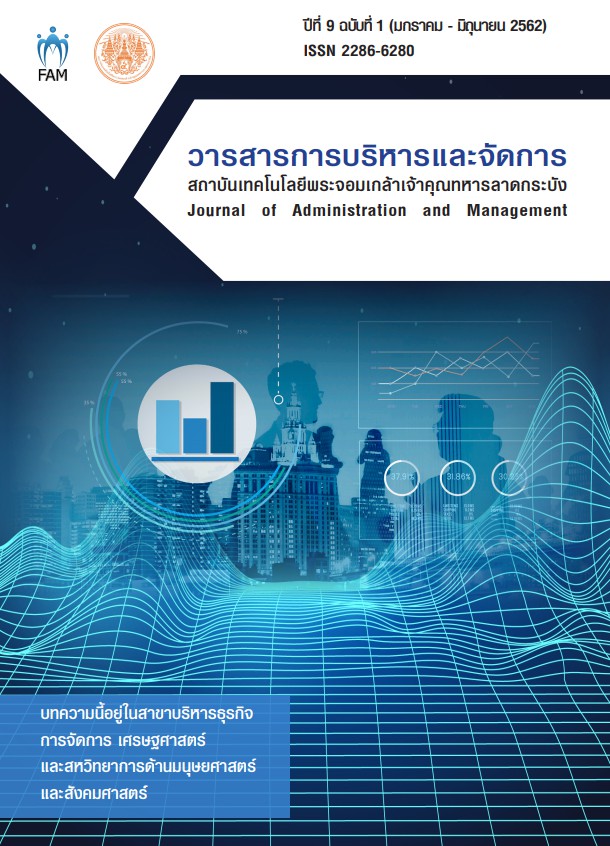Relationship between Ownership Concentration and Dispersion and Stock Liquidity of the Listed Companies in the Stock Exchange of Thailand
Main Article Content
Abstract
The purposes of this research were to examine the relationship between ownership concentration and stock liquidity as well as the relationship between ownership dispersion and stock liquidity. A sample used in the research was the listed companies in the stock exchange of Thailand in 2011 – 2015 in which 418 companies who have complete data were selected; as a result, there were 2,090 data in total. In analyzing the collected data there were two methods used: descriptive statistics and multiple regression analysis, hypothesis testing. The findings indicated that PROPCON owned the most data, but RESOURC owned the least data. Observing the relationship between independent variable and dependent variable, ownership concentration appeared to be negatively related to turnover and liquidity ratio and to be positively related to r-spread whereas ownership dispersion showed a positive relationship with liquidity ratio and a negative relationship with r-spread.
Article Details
Journal of KMITL Business School is available both online and in printed version.
**All articles or opinions presented in this issue of the Journal of KMITL Business School reflect the thoughts of their respective authors. This journal serves as an independent platform for a variety of viewpoints. Authors bear full responsibility for the content of their articles.**
**All articles published in this journal are copyrighted by KMITL Business School, King Mongkut's Institute of Technology Ladkrabang. The editorial team permits copying or using articles, but a reference to the journal is required.**
References
สัจจวัฒน์ จันทร์หอม. (2554). คุณภาพกำไรของบริษัทที่มีโครงสร้างการถือหุ้นและการบริหารงานโดยครอบครัว. บัญชีมหาบัณฑิต, มหาวิทยาลัยธรรมศาสตร์
________. (ม.ป.ป.). มูลค่าการซื้อขายของนักลงทุนในตลาดหลักทรัพย์แห่งประเทศไทย. วันที่ค้นข้อมูล 25 มกราคม 2559, เข้าถึงได้จาก http://www.setsmart.com/ism/investorType.html
________. (ม.ป.ป.). บริษัทที่จดทะเบียนในตลาดหลักทรัพย์แห่งประเทศไทย . วันที่ค้นข้อมูล 25 มกราคม 2559, เข้าถึงได้จาก http://www.setsmart.com/ism/brokerProfile.html
Amihud, Y. (2002). Illiquidity and stock returns: cross-section and time-series effects. Journal of financial markets, 5(1), 31-56.
Brockman, P., Chung, D. Y., & Yan, X. S. (2009). Block ownership, trading activity, and market liquidity. Journal of Financial and Quantitative Analysis, 44(06), 1403-1426.
Chai, D., Faff, R., & Gharghori, P. (2010). New evidence on the relation between stock liquidity and measures of trading activity. International Review of Financial Analysis, 19(3), 181-192.
Chordia, T., Shivakumar, L., & Subrahmanyam, A. (2001). The cross-section of daily variation in liquidity. London Business School Accounting Subject Area, (012).
Fan, J. P., & Wong, T. J. (2002). Corporate ownership structure and the informativeness of accounting earnings in East Asia. Journal of accounting and economics, 33(3), 401-425.
Gorkittisunthorn, M., Jumreornvong, S., & Limpaphayom, P. (2006). Insider ownership, bid–ask spread, and stock splits: Evidence from the Stock Exchange of Thailand. International Review of Financial Analysis, 15(4), 450-461.
Heflin, F., & Shaw, K. W. (2000). Blockholder ownership and market liquidity. Journal of Financial and Quantitative Analysis, 35(04), 621-633.
Jacoby, G., & Zheng, S. X. (2010). Ownership dispersion and market liquidity.International Review of Financial Analysis, 19(2), 81-88.
Menard, S. (1995). Applied logistic regression analysis: Sage university series on quantitative applications in the social sciences.
Pathirawasam, C., & Wickremasinghe, G. (2012). Ownership Concentration and Financial Performance: The Case of Sri Lankan Listed Companies. Corporate Ownership and Control, 9(4), 170-177.
Rhee, S. G., & Wang, J. (2009). Foreign institutional ownership and stock market liquidity: Evidence from Indonesia. Journal of Banking & Finance, 33(7), 1312-1324.
Rubin, A. (2007). Ownership level, ownership concentration and liquidity. Journal of financial Markets, 10(3), 219-248.


